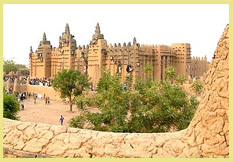




Woodlands

Deciduous woodlands - shown in light green on the map - extend across vast areas of tropical Africa, where the climate is too seasonal and dry to support evergreen forest. Woodlands cover about 25% of the continent and represent the most widespread vegetation type in tropical Africa, with a northern (‘Sudanian') belt stretching from Senegal to the Ethiopian highlands, and a southern (‘Zambesian') belt at similar latitudes south of the equator. Superficially woodlands in different parts of the continent may look quite similar, but there are subtle differences in the species which dominate the Sudanian ‘Isoberlina' woodlands in the north and the Zambesian ‘miombo' woodlands to the south. Most African woodlands are infested with tse-tse flies which transmit the deadly nagana disease to cattle, and sleeping sickness to man. As a result, large areas of Africa's woodlands have been protected against human occupation and influence, remaining as the continent's great untouched wilderness areas. These are the lands where wildlife reign supreme - great herds of elephants and buffaloes, sable and roan antelope and the occasional rhino.
There are five world heritage sites in Africa's deciduous woodlands - three in West Africa and the other two in eastern and southern Africa. Tanzania's Selous Game Reserve is one of the world's largest protected areas - 50,000 square kilometres, bigger than Switzerland - supporting 60,000 elephants, 150,000 buffalo and 40,000 hippos. Most importantly, it is one of the last strongholds of the black rhino and African wild dog. Further south, Mana Pools National Park protects a scenic stretch of the great Zambesi valley where animals congregate in the dry season in huge numbers. The West African sites include some of the largest remnants of intact woodland in the sub-region, although all have been impacted by sustained poaching and populations of large mammals are small compared with those found in similar sites in eastern or southern Africa. Niokolo-Koba National Park in Senegal is one of the last sanctuaries for West African species such as the Derby's Eland and Guinea Baboon, while Comoe National Park in Cote D'Ivoire has an exceptional diversity of habitats due to its more southerly location, closer to the Upper Guinea rainforests. Both these sites are included on the List of World Heritage In Danger, as a result of poaching and the effects of war in Cote D'Ivoire. ‘W' National Park in Niger is considerably smaller, but includes some scenic sections of the Niger River, and should be able to sustain viable populations of species typical of this part of Africa because it adjoins larger protected areas across the border in Burkina Faso and Benin. Follow the links to learn more about these amazing places!
Slideshow of the main features of Africa's world heritage woodlands
Iconic Species: The deciduous woodlands evoke images of wild Africa - massive herds of buffalo and elephants thundering through the trees in clouds of dust, pursued by flocks of oxpeckers.....and along the banks of mighty rivers, huge crocodiles basking in the sun while hippos grunt their perpetual chorus of content.
Missing links: The woodlands of Africa are well represented by the five existing sites, although there are many other areas which deserve consideration as management improves and trans-frontier consolidation of protected areas takes place. The world heritage site at ‘W' National Park needs to be extended to include the contiguous parks in Burkina Faso and Benin, while further sites in southern Africa should be considered, including Luangwa Valley and Kafue National Parks (Zambia), the Greater Ruaha system (Tanzania), Upemba (Congo), Chobe (Botswana), Niassa (Mozambique) and the Kruger trans-frontier park (South Africa and Mozambique)
.jpg)



